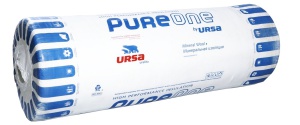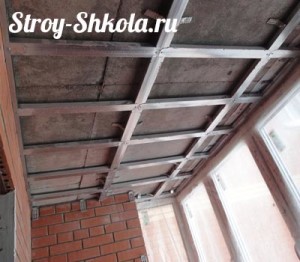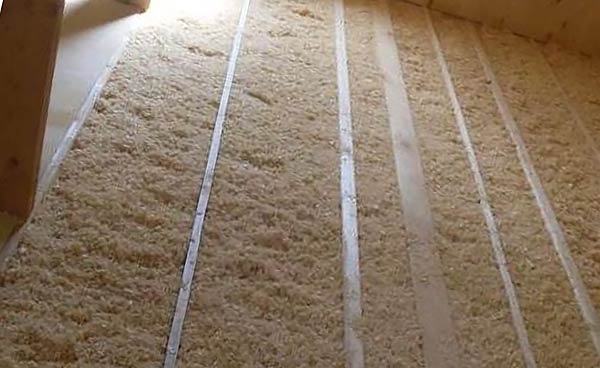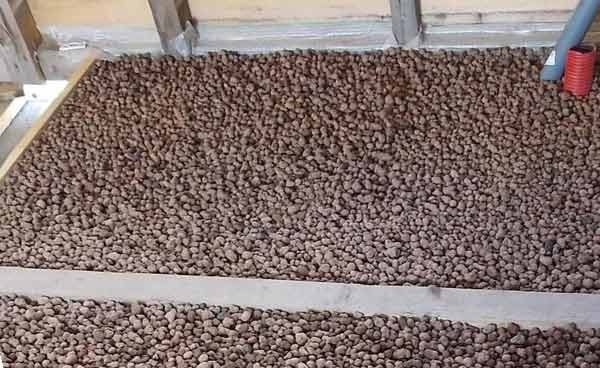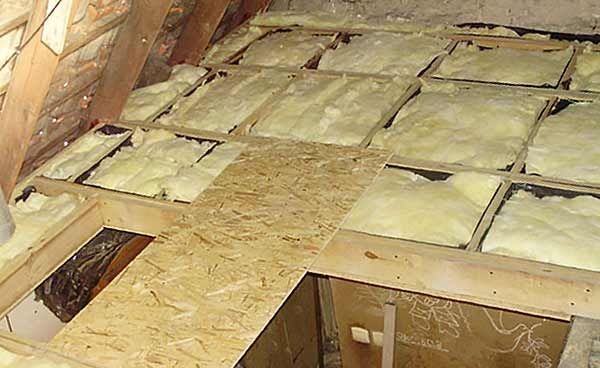How to choose the right thickness of insulation

- For an external wall, where it is necessary to achieve a normative indicator of the resistance of the material to heat transfer, the recommended thickness of mineral wool should be from 8 to 10 cm.
- For basements (walls, ceilings), surfaces in contact with the ground - a layer of insulating material should be from 6 to 15 cm.
- The thickness of the mineral wool for the floor in a heated room is at least 6 centimeters, with a maximum thickness of 15 cm.
- The thickness of the mineral wool for the ceiling of a house in contact with an unheated attic should vary between 10 and 16 cm.
- Pitched roofs should be insulated with heat-insulating material with a thickness of 15 to 30 cm.
Average data may vary depending on the climate in the region where you live.
Internal insulation
The need for internal insulation of the ceiling is most typical for houses with several floors or with an attic, as well as for city apartments. The entire scope of work consists of the following stages:
- Ceiling lathing - can be made of boards with a section of 30-40 x 100-200 mm (the width of the board directly depends on the thickness of the insulation layer) or a metal profile. The crate is attached to the ceiling with nails or self-tapping screws, while the distance between adjacent parts should be about 50-60 cm, depending on the width of the mineral wool used.
Ceiling trim
A layer of waterproofing is attached to the finished crate - strips 50-60 cm wide are cut out, plus a tolerance of 5 cm on each side, i.e. the total width will be 60-70 cm. These strips are fastened with counter rails to a wooden crate or with self-tapping screws to the profile.
Next, mineral wool is laid and fixed with glue or a construction stapler to the ceiling, with a large layer thickness - to the crate.
Fastening mineral wool to the ceiling
The next layer is a vapor barrier using glassine. It is mounted on mineral wool using a stapler.
The finished structure is fixed by transverse fixation of the counter-rails or profile.
We fix mineral wool to the ceiling
The procedure for internal insulation is completed, the next step is the installation of drywall, panels or stretch ceilings on the crate.
How much does it cost to insulate the ceiling with mineral wool
The relevance of insulation in general depends on the region and climate conditions where the house is located. These indicators should be taken into account when planning the methods of insulation and the use of the necessary material.
Modern construction in the project itself lays a point on insulation work, since this is an obligatory measure of energy-saving trends of our time.
Due to its low cost and quality, mineral wool is more often used for the insulation process at home. Such work can be carried out with your own hands, then the insulation of the ceiling will be much cheaper than using hired workers.
The average price of a standard mineral wool roll (10 m long, 1.2 m wide and 5-20 cm thick) is about 1200 rubles. This means that 1 m 2 of mineral wool costs 100 rubles.
The cost of work on the insulation of 1 m 2 of the area is about 70 rubles (at the beginning of 2015). Based on this, the insulation of the ceiling of a house of 20 m 2 will be: (1200 rubles * 2) + 120 rubles * 20 m 2 = 2400 + 2400 = 4800 rubles.
Also watch an interesting video about the insulation of the ceiling with mineral wool
3 comments: Mineral wool ceiling insulation technology.
Should ceilings be insulated in a wooden house?
Wood is a building material with good thermal conductivity. This property affects the loss of heat in the room, especially if its ceiling is also made of wooden materials. Experts have calculated that heat loss through the ceiling in a wooden house (without proper thermal insulation) can be 20%. The reason for this lies in the laws of physics: the warm air inside the room rises and flies out through a poorly insulated ceiling with all kinds of cracks. Therefore, insulation is a necessity, especially in a private house, and helps to avoid significant energy costs.
How to properly insulate the ceiling in the house with sawdust
When the ceiling is insulated with sawdust, the house turns out to be warm and environmentally friendly. For this process, well-dried clean sawdust of medium or large size is purchased. From below, sheet or rolled parchment is used. Lime and copper sulfate are used as an antiseptic and protection against rodents. The average layer of insulation of a wooden house, bathhouse or cottage is 25 cm.
To prepare a heater with your own hands, take:
- 10 buckets of sawdust;
- lime bucket,
- 250 grams of copper sulfate;
- a bucket of cement;
- 10 liters of water.
Lime and blue vitriol are mixed with dry cement. The mixture is poured into sawdust and kneaded, then water is slowly poured in. The resulting mixture should form a homogeneous dense structure.
The chimney is insulated with fire-resistant material, and the wiring is closed with a metal pipe. The parchment is spread, then the sawdust mixture is poured and rammed. After this flooring remains to dry for 2 weeks.
How to make ceiling insulation in a wooden house with expanded clay
Expanded clay is environmentally friendly, refractory, does not rot, is not exposed to various temperatures
Rodents do not start in expanded clay, which is important for owners of wooden houses. Steam and waterproofing is spread in the upper part of the ceiling
Pipe, wiring are insulated with refractory materials (sheet metal or iron pipes).
Waterproofing or parchment is spread, while the width of the material should be 10 centimeters greater than the distance between the beams of the house. Laying is carried out with an overlap on beams, walls. The roofing material is fixed with rubber-based mastic. When using simple adhesive tape at the joints, aluminum plates are additionally installed.
With an overlap of 15 cm, there is a vapor barrier, and the exit to the walls after backfilling with expanded clay is also 15 cm. A 50 mm layer of clay is laid out, then there is a layer of expanded clay. The minimum thickness is about 15 cm. A screed of sand and cement is poured onto it. To use the attic, chipboard or plank flooring is made from above.
Insulation of the ceiling in the house with mineral wool
Basalt and mineral wool reduce the thermal conductivity of the ceiling. These types of insulation are easy to install and environmentally friendly. They cost a little more than previous analogues, but they allow you to insulate the outside and inside of the ceiling. Plates are used outside.
When insulating the ceiling in a wooden house, the vapor barrier is laid out with an overlap of 15 cm. The overlap lies on the walls, the beams and are fixed, and mineral wool is laid between the beams. When using rolls, keep in mind that they must fit the openings. Rolling is carried out along the location of the beams. The mats are tightly packed. Another layer of insulation is laid across the top.
Beams, joints are hidden, and the gaps are sealed with mounting foam. A vapor barrier is laid with an overlap of 15 cm. The seams are glued with adhesive tape. From above there is a screed of cement with sand. In a residential attic, boards or laminate are laid on the screed.
Insulation in a wooden house with foam
The most reliable type of insulation for the home is the use of polyurethane foam or polystyrene foam boards. These materials are the most expensive.Installation, in comparison with the previous view, is more time-consuming from the inside, but at the same time, the attic area in this option is the least lost. The insulation lies more tightly than others during the insulation of the ceiling in a wooden house.
A rolled vapor barrier is mounted on the inside of the ceiling of the house. Styrofoam is tightly inserted between the bars. To do this, it is measured and cut to size. Then comes another layer of vapor barrier material with an overlap of 15 cm. The seams are closed. A crate of wooden or iron bars with a cross section of 5 by 5 centimeters is installed on the beams. A ceiling made of GKL or GVL is attached to it.
All these materials can be used for insulation in a private house, bathhouse or cottage. Knowing how to insulate a ceiling in a wooden house with your own hands, you can complete repair or construction work in a short time without involving specialists. Insulation not only allows you to keep warm in the house, but also becomes a good option for soundproofing.
Ceiling insulation basic methods
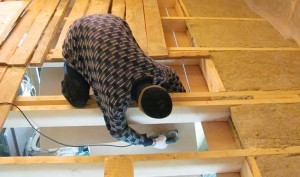
- Warming from the inside. It is simple, but it can also cause undesirable consequences in the form of a decrease in the overall height of the room, ingress of fumes from heat-insulating materials into it, the appearance of mold and fungus in the insulation itself.
- Insulation from the outside (that is, from the side of the attic). The ceiling in this case will be the floor of the attic, and you can not be afraid that fumes from thermal insulation can get into the dwelling itself.
The insulation itself, that is, the procedure, depends on the chosen thermal insulation material.
